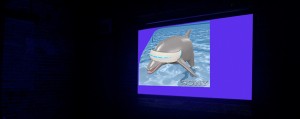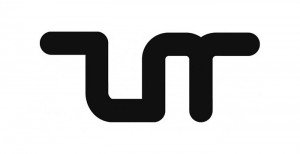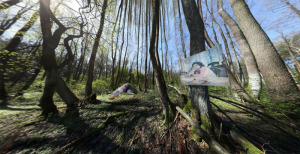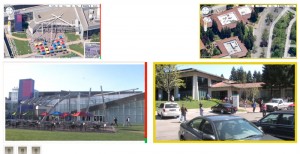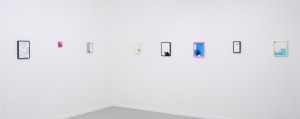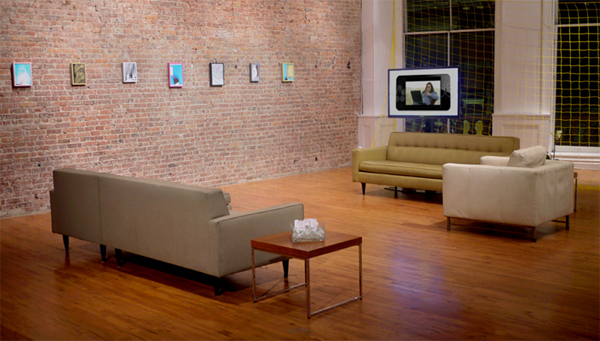“In general I just don’t consider myself an artist or a curator,” writes Lucy Chinen in a long and thoughtful email exchange, based on her practice at large and the forthcoming group exhibition, Over the Valley at Steve Turner Contemporary, that she curates. Interesting, that with the modern focus on interdisciplinarity, Chinen would opt-out of an art world that has discomfitingly expanded into serious critical discourse around the likes of James Franco‘s General Hospital installation and Jay-Z’s meta-performance. But perhaps the definition of “art” is really no longer a relevant one. As prevalence generally correlates with value, the more you have of something, the less you want it and the lower its worth. It’s a sentiment Finnish video artist Jaakko Pallasvuo shared in a recent interview with aqnb where he blames the ubiquity and subsequent devaluation of the image (perhaps, echoing the ubiquity and subsequent devaluation of the artist) for his migration into writing: “I don’t feel like a visual artist anymore”.
Similarly, Chinen is less interested in media production and more interested in mediation. A turning point came with a lucid and incisive analysis of Web 2.0 in an essay, ‘Social and Connected: The Integration of Networked Language in ‘Connecting’’ as she began to recognise patterns in her own interactions with social media networks, leading to a growing fascination with the machinations behind tech companies and her compulsion to identify and catalogue them.
As an LA resident without a driver’s license, Chinen found herself wandering the stateless realm of the web early on, engaging with an artistic set across borders. That’s how Over the Valley features six artists from around the US and Europe, none of them based in Silicon Valley, from which the exhibition takes its title. That’s how, during a written and online interaction, Chinen can discuss criticality and subversion, artistic processes and perspectives, the angry red lines of my “English (UK)” setting on Microsoft Proofing being the only indication of our physical separation. That’s because all of us, as Chinen writes, “contribute to the core functionality of companies that use data, it’s almost a house we all live in, a company we all work for”.

aqnb: You seem fairly concerned with the subliminal effects of corporate advertising and its use as a form of control, when do you think you first became aware of this?
Lucy Chinen: I became interested in how it has so quickly adapted to technology and how advertising can be so ingrained within media. I’m naturally attracted to how these platforms make people feel. I became aware that that’s what I was concerned with when I saw that everything I was tweeting about or posting on Facebook was about that.
aqnb: In ‘Social and Connected’, you talk about advertising looking less and less like advertising as it infiltrates our social media feeds. Do you think the contemporary art aesthetic, particularly in post-internet art, reflects that, by itself looking more and more like advertising?
LC: There is definitely a blurry line between minimal corporate advertising and corporate aesthetic in art. Yet, I think lots of artists who make objects that are influenced by networked society are interested in advertising also because advertising advertises an idea, not just a product. It seems that artists are being inspired and almost looking at what art can learn from it as a psychological force.
I also see how technology has lots to learn from art, not just aesthetically. There are things that artists do that are free from being monetarily functional so its a very accelerated version of what’s happening now in technology. The artist doesn’t necessarily have to create that technology, just highlight the possibility; point toward a potential future that hasn’t been defined yet.
aqnb: Is it a subversive act?
LC: One thing I wonder sometimes is, how an artist can retain criticality if the art ends up looking or functioning similarly to the thing the artist is criticizing. Being subversive now doesn’t necessarily mean controversial, so it can be hard to distinguish if what is created is actually different from the system it is seeking to critique. I am unsure if being self-aware is enough to make it different. Additionally, I think whether it is actually subversive depends on a viewer’s understanding of what the artist is trying to subvert.
In an interview I did with Katja Novistkova for the catalog I asked a question relating to similar processes within art and technology one thing she said was, “I’m sure that some of the works being made by artists today will end up as ‘immaterial’ influences in the upcoming technological transformations; doesn’t matter if it happens via Hollywood, Art Basel or Internet.” I agree with this and following this idea I personally would rather see something interesting regardless of its ‘field’ or context. Cross-pollination of methods and techniques is natural, as artists comment on culture.
aqnb: In the Over the Valley press release, you make a point of mentioning that these artists are all unrelated, yet, share similar concerns.
LC: I mentioned that they are unrelated because they are all very different in the way the works look, and also the approach. One thing I intentionally wanted to explore was how a piece can become relevant again.
Electronic Disturbance Theater made the Transborder Immigrant Tool in 2007 and that doesn’t seem like too long ago but I feel that piece is very specific to what was happening within the early intersection of activism and technology as art. They have contributed to the dialogue of civil disobedience and its almost like the actual functionality of the application on the phones doesn’t matter, it was a gesture to evoke response and to call attention to the legality of crossing a boundary that isn’t defined yet.
This concept comes up again with the use of peoples data, patent trolls and offshore companies; working around legality due to undefined territory occupied by digital transactions. This is something Goldin+Senneby and Metahaven in their larger practice are focused on as well.
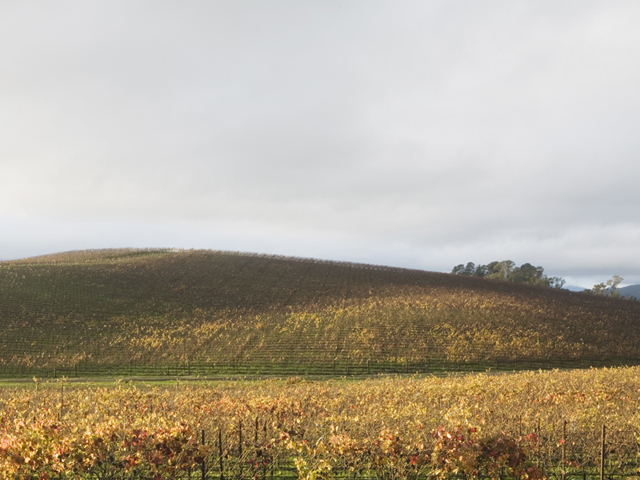
Andrew Norman Wilson looks into the human hand in the digitization of printed material and a part of his larger practice looks into the whole structure of a company, the network of different hands involved in producing something of tangible and intangible value. Then, on the other end, Michael Manning really embraces and celebrates the use of these corporate platforms, joyfully working with the structure defined by the company. Katja Novitskova looks into periods of rapid growth in space, nature and the internet. Her present practice looks into ancient cultures to predict future trends. So you see the variety of approaches these artists have and, through this selection, I have appreciated looking into these diverse perspectives on the matter.
aqnb: In ‘Social and Connected’ you talk about this idea of “auto propaganda” and its effect on shaping perspectives.
LC: The way a network is structured has a tremendous effect on the way you think when you use online tools or services. Boris Groys has written about the way one thinks of a question adapting to the way the Google search engine works and Metahaven talks about current design as a “Fischer Price interface culture with one or two buttons that do everything… representing a deliberate oversimplification of the world.”
It might sound sort of silly to think about your iPhone or Google search indoctrinating you but, if you use something everyday, the way that thing is structured, what you see and what you don’t see, starts to condition your expectations. One day, you can be using Gmail, YouTube, GoogleDocs, GoogleDrive, etcetera, and the next you find yourself in a theater watching a GoogleComedy staring Vince Vaughn and Owen Wilson called The Internship and you think to yourself “is this normal?”
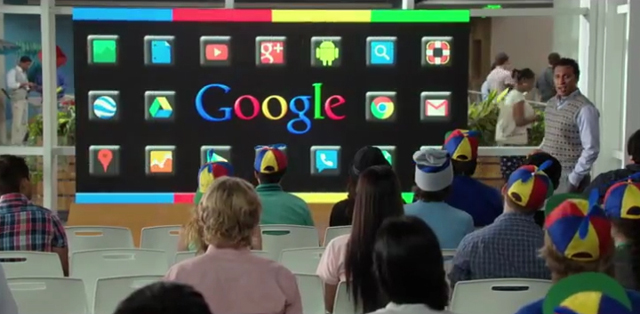
aqnb: This selection of artists could also potentially be reflective of that capitalist model of new market generation, is that something you’d considered when putting the show together?
LC: When I gathered these works it became apparent that it wasn’t about Google, Microsoft, Amazon or Apple. It was an ideology that makes use of the way people view technology, with awe, wonder and confusion, which is also a place that is ripe for new markets. One example would be app culture. The idea that you could create the next big app or internet business, in general, where someone says, ‘it’s like this [a basic business model]…but online!’ For example, the online art fair or online art collecting within s[edition].
aqnb: In an interview around ‘artobj-cult.biz’ (2011), you’re really speaking the language of an expanding art world, one that is continuously absorbing new industries.
LC: Art Object Culture was a project I worked with Emilie Gervais on. We discontinued this platform of an online gallery when the time for that was over. Bank of America now has their online gallery and it seemed like an appropriate end to that project, if you visit the site now we just ‘iframed’ the Bank of America online gallery with a link to the archive of projects that were featured on the website.
When we responded to that interview, Emilie and I spoke in a very art e-commerce embracing way. It was also the same time that people were flirting with the idea that you were a curator of everything, clothes, food etc. We were seeing all these images of artworks online and they would be constructed entirely of commercial products. It also seemed like people were trying to come up with so many constructs as to how work online would be sold and it started to become so complicated, with all these arrangements of what you actually receive in return and it’s just meant to be a signifier of a physical object. In the end, the concept of an online gallery was also realized by Bank of America and so was the direct linking of products within an image.
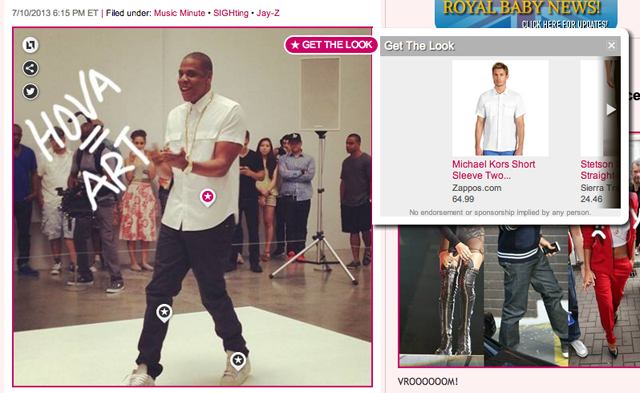
aqnb: More generally, do you think the developed world is experiencing a period of entropy? Perhaps, it’s following a natural cycle, where things need to decay before they can regenerate.
LC: To me it starts to get really interesting when old structures and definitions, such as patents, intellectual property and privacy, are drastically changed by media. The old rules don’t make sense anymore and now these things have to be ethically reconsidered.
I think there is a period of time when people stop saying “THIS IS AWFUL” or “AMAZING” because it’s neither. There are aspects to the commercialization of society that are very interesting because they utilize new technologies or ideas and then there are times where it is just empty content. Likewise, the boom in the digitization of society is not all amazing and great and not every interaction should be digitized. Yet, it is also not the cause of all our problems. **
share news item
